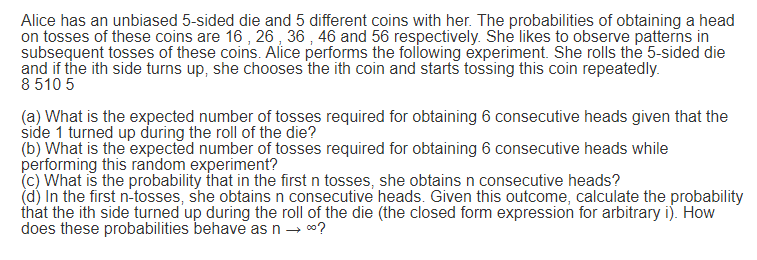Alice has an unbiased 5-sided die and 5 different coins with her. The probabilities of obtaining a head on tosses of these coins are 16, 26, 36, 46 and 56 respectively. She likes to observe patterns in subsequent tosses of these coins. Alice performs the following experiment. She rolls the 5-sided die and if the ith side turns up, she chooses the ith coin and starts tossing this coin repeatedly. 8 510 5 (a) What is the expected number of tosses required for obtaining 6 consecutive heads given that the side 1 turned up during the roll of the die? (b) What is the expected number of tosses required for obtaining 6 consecutive heads while performing this random experiment? (c) What is the probability that in the first n tosses, she obtains n consecutive heads? (d) In the first n-tosses, she obtains n consecutive heads. Given this outcome, calculate the probability that the ith side turned up during the roll of the die (the closed form expression for arbitrary i). How does these probabilities behave as n → ∞?
Alice has an unbiased 5-sided die and 5 different coins with her. The probabilities of obtaining a head on tosses of these coins are 16, 26, 36, 46 and 56 respectively. She likes to observe patterns in subsequent tosses of these coins. Alice performs the following experiment. She rolls the 5-sided die and if the ith side turns up, she chooses the ith coin and starts tossing this coin repeatedly. 8 510 5 (a) What is the expected number of tosses required for obtaining 6 consecutive heads given that the side 1 turned up during the roll of the die? (b) What is the expected number of tosses required for obtaining 6 consecutive heads while performing this random experiment? (c) What is the probability that in the first n tosses, she obtains n consecutive heads? (d) In the first n-tosses, she obtains n consecutive heads. Given this outcome, calculate the probability that the ith side turned up during the roll of the die (the closed form expression for arbitrary i). How does these probabilities behave as n → ∞?
College Algebra
7th Edition
ISBN:9781305115545
Author:James Stewart, Lothar Redlin, Saleem Watson
Publisher:James Stewart, Lothar Redlin, Saleem Watson
Chapter9: Counting And Probability
Section9.3: Binomial Probability
Problem 1E: A binomial experiment is UDC in which there are exactly __________ outcome. One outcome is called...
Related questions
Question

Transcribed Image Text:Alice has an unbiased 5-sided die and 5 different coins with her. The probabilities of obtaining a head
on tosses of these coins are 16 , 26 , 36 , 46 and 56 respectively. She likes to observe patterns in
subsequent tosses of these coins. Alice performs the folowing experiment. She rolls the 5-sided die
and if the ith side turns up, she chooses the ith coin and starts tossing this coin repeatedly.
8 510 5
(a) What is the expected number of tosses required for obtaining 6 consecutive heads given that the
side 1 turned up during the roll of the die?
(b) What is the expected number of tosses required for obtaining 6 consecutive heads while
performing this random experiment?
(c) What is the probability that in the first n tosses, she obtains n consecutive heads?
(d) In the first n-tosses, she obtains n consecutive heads. Given this outcome, calculate the probability
that the ith side turned up during the roll of the die (the closed form expression for arbitrary i). How
does these probabilities behave as n → 0?
Expert Solution
This question has been solved!
Explore an expertly crafted, step-by-step solution for a thorough understanding of key concepts.
Step 1: Describe the given information
VIEWStep 2: Determine the expected no. of tosses required to obtain 6 consecutive heads if 1 turned up
VIEWStep 3: Determine the expected no. of tosses to obtain 6 consecutive heads while performing the experiment
VIEWStep 4: The probability to obtain n consecutive heads
VIEWStep 5: Determine how probabilities behave
VIEWSolution
VIEWStep by step
Solved in 6 steps with 36 images

Recommended textbooks for you

College Algebra
Algebra
ISBN:
9781305115545
Author:
James Stewart, Lothar Redlin, Saleem Watson
Publisher:
Cengage Learning

College Algebra
Algebra
ISBN:
9781305115545
Author:
James Stewart, Lothar Redlin, Saleem Watson
Publisher:
Cengage Learning